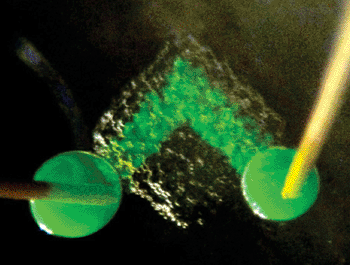Soft-3D Printer Produces Synthetic Tissue-Like Material
By LabMedica International staff writers
Posted on 17 Apr 2013
Scientists have succeeded to custom build a unique, programmable soft-3D printer able to create materials that mimic several properties of living tissue.Posted on 17 Apr 2013
Current synthetic mimics of cells, such as liposomes, are typically incapable of cooperation and therefore cannot readily display collective tissue-like behavior. The new printer creates aqueous “droplet networks” that could become the building blocks of a new form of technology that potentially could replace or interface with damaged human tissues. Because droplet networks are entirely synthetic, have no genome, and do not replicate, they avoid some of the problems associated with other approaches to creating artificial tissues – such as those that use stem cells. The new technology has the potential to provide new tissue engineering substrates, to be developed into functional mimics of various living tissues, as well as to improve targeted drug delivery methods.
“Conventional 3D printers aren't up to the job of creating these droplet networks, so we custom built one in our [lab],” said Hagan Bayley, professor of chemistry at Oxford University (Oxford, UK), who led the research. “At the moment we've created networks of up to 35,000 droplets, but the size of network we can make is really only limited by time and money. For our experiments we used two different types of droplet, but there's no reason why you couldn't use 50 or more different kinds.” The networks in the present study remained stable for weeks.
The soft-3D printer and the research of its initial application have been described in a study published in the journal Science, on April 5, 2013. The printer was built by lead author Gabriel Villar, a PhD student in Prof. Bayley’s group. The new type of printed material consists of thousands of picoliter water droplets that become connected by single lipid bilayer films to form a cohesive material with cooperating compartments. Each droplet compartment is about 50 micrometers in diameter; although this is about five times larger than mammalian cells, the researchers believe it can be reduced. The 3D structures can be built with heterologous droplets in software-defined arrangements and can be designed to perform certain functions of cooperating cells. For example, the droplet networks can be functionalized with membrane proteins to allow rapid electrical communication along a specific path.
The droplet networks can also be programmed by osmolarity gradients to fold into otherwise unattainable, designed structures. They can be designed to fold themselves into different shapes after printing—for example, a flat shape that resembles the petals of a flower is “programmed” to fold itself into a hollow “ball,” which cannot be obtained by direct printing. This folding (see videos), which resembles muscle movement, is powered by osmolarity differences that generate water transfer between droplets.
“We aren't trying to make materials that faithfully resemble tissues but rather structures that can carry out the functions of tissues. We’ve shown that it is possible to create networks of tens of thousands connected droplets. The droplets can be printed with protein pores to form pathways through the network that mimic nerves and are able to transmit electrical signals from one side of a network to the other,” said Prof. Bayley. Mr. Villar added, “We have created a scalable way of producing a new type of soft material. The printed structures could in principle employ much of the biological machinery that enables the sophisticated behavior of living cells and tissues.”
Related Links:
Oxford University

















